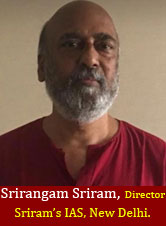“The deepening digital divide that India is rudely exposed to, is a threat to social development in India.” Examine the statement.
Sakshi Education
By Srirangam Sriram, Sriram's IAS, New Delhi.


According to the Telecom Regulatory Authority of India, in 2018, total internet density in the country stood at about 49 percent. Of that, 25 percent lived in rural areas and 98 percent in urban areas. Access to electricity is crucial for digital services like health, medicine and education, both for powering devices as well as for connecting to the internet. Erratic power supply only exacerbates the existing digital divide, which is evident across class, gender, region and place of residence. According to National Sample Survey Organisation (2018) estimates, among the poorest 20 percent households, only 2.7 percent have access to a computer and 8.9 percent to internet facilities. In the case of the top 20 percent households, the proportions are 27.6 percent and 50.5 percent, respectively.
Certain regions in the country that have poor connectivity are left behind in ensuring access to financial services thereby creating a digital divide and thus financial inclusion suffers.
Forced by the limits that covid-19 has exerted, worldwide, both primary care doctors and healthcare providers are adopting digital options to deliver patient care. Telemedicine is gaining ground. Medicines can also be ordered on line for physical supply. But digital divide is the constraint.
 Government is using digital technology in healthcare include through Digital India Mission enabling wider technology adoption by masses, deeper penetration of smartphones and mobile apps, ubiquitous last mile connectivity and cheaper data plans. NEP 2020 is committed to promoting robust digital education. It is critical for social development centered around education, health and financial inclusion.
Government is using digital technology in healthcare include through Digital India Mission enabling wider technology adoption by masses, deeper penetration of smartphones and mobile apps, ubiquitous last mile connectivity and cheaper data plans. NEP 2020 is committed to promoting robust digital education. It is critical for social development centered around education, health and financial inclusion.
Certain regions in the country that have poor connectivity are left behind in ensuring access to financial services thereby creating a digital divide and thus financial inclusion suffers.
Forced by the limits that covid-19 has exerted, worldwide, both primary care doctors and healthcare providers are adopting digital options to deliver patient care. Telemedicine is gaining ground. Medicines can also be ordered on line for physical supply. But digital divide is the constraint.
 Government is using digital technology in healthcare include through Digital India Mission enabling wider technology adoption by masses, deeper penetration of smartphones and mobile apps, ubiquitous last mile connectivity and cheaper data plans. NEP 2020 is committed to promoting robust digital education. It is critical for social development centered around education, health and financial inclusion.
Government is using digital technology in healthcare include through Digital India Mission enabling wider technology adoption by masses, deeper penetration of smartphones and mobile apps, ubiquitous last mile connectivity and cheaper data plans. NEP 2020 is committed to promoting robust digital education. It is critical for social development centered around education, health and financial inclusion.Published date : 30 Nov 2020 01:27PM













